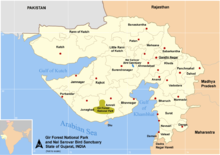Singa Asia
| Singa Asia | |
|---|---|

| |
| Jantan | |

| |
| Betina | |
| Pengelasan saintifik | |
| Domain: | Eukaryota |
| Alam: | Animalia |
| Filum: | Chordata |
| Kelas: | Mammalia |
| Order: | Carnivora |
| Suborder: | Feliformia |
| Keluarga: | Felidae |
| Genus: | Panthera |
| Spesies: | |
| Subspesies: | P. l. persica
|
| Nama trinomial | |
| Panthera leo persica Meyer, 1826
| |

| |
| Taburan Singa Asia liar semasa | |
| Sinonim[2] | |
|
Panthera leo asiaticus | |
Singa Asia (Panthera leo persica), juga dikenali sebagai singa India dan singa Parsi,[3][4] merupakan salah satu subspesies singa yang hidup sebagai satu populasi tunggal di Gujarat, India. Ia tersenarai sebagai Terancam dalam Senarai Merah IUCN kerana saiz populasinya kecil.[1]
Singa Asia mula-mula dihuraikan oleh ahli zoologi Austria Johann N. Meyer di bawah trinomen Felis leo persicus.[5] Taburan sejarahnya mencakupi negara-negara Turki, Iran, Mesopotamia, dan India Tengah mulai timur Sungai Indus di bekas Wilayah Sind hingga Benggala dan Sungai Narmada.[6][7]
Sejak tahun 2010, populasi singa di dalam dan sekitar Taman Negara Hutan Gir meningkat stabil.[8] Pada Mei 2015, Banci Singa Asia ke-14 diadakan di kawasan seluas 20,000 km²; populasi singa dianggarkan sebanyak 523 ekor individu, iaitu 109 jantan dewasa, 201 betina dewasa dan 213 anak.[9][10] Pada Ogos 2017, Banci Singa Asia mendapati 650 ekor individu liar.[11][12]
Singa Asia merupakan salah satu daripada lima jenis rumpun harimau yang diketahui hidup di India, di samping harimau Benggala, harimau bintang India, harimau bintang salji dan harimau dahan.[13][14]
Rujukan
[sunting | sunting sumber]- ^ a b Breitenmoser, U., Mallon, D. P., Ahmad Khan, J. and Driscoll, C. (2008). "Panthera leo ssp. persica". Senarai Merah Spesies Terancam IUCN Versi 2017-1. Kesatuan Pemuliharaan Alam Sekitar Antarabangsa.CS1 maint: multiple names: authors list (link) CS1 maint: ref=harv (link)
- ^ Wozencraft, W. C. (2005). "Order Carnivora". Dalam Wilson, D. E.; Reeder, D. M (penyunting). Mammal Species of the World (ed. 3rd). Johns Hopkins University Press. m/s. 546. ISBN 978-0-8018-8221-0. OCLC 62265494.CS1 maint: ref=harv (link)
- ^ Heptner, V. G.; Sludskii, A. A. (1992) [1972]. "Lion". Mlekopitajuščie Sovetskogo Soiuza. Moskva: Vysšaia Škola [Mammals of the Soviet Union, Volume II, Part 2]. Washington DC: Smithsonian Institution and the National Science Foundation. m/s. 83–95. ISBN 90-04-08876-8. Unknown parameter
|chapterurl=ignored (bantuan) - ^ Humphreys, P., Kahrom, E. (1999). Lion and Gazelle: The Mammals and Birds of Iran. Images Publishing, Avon.
- ^ Meyer, J. N. (1826). Dissertatio inauguralis anatomico-medica de genere felium. Doctoral thesis, University of Vienna.
- ^ Pocock, R. I. (1939). "Panthera leo". The Fauna of British India, including Ceylon and Burma. Mammalia. – Volume 1. London: Taylor and Francis Ltd. m/s. 212–222.
- ^ Nowell, K., Jackson, P. (1996). "Asiatic lion". Wild Cats: Status Survey and Conservation Action Plan (PDF). Gland, Switzerland: IUCN/SSC Cat Specialist Group. m/s. 17–21. ISBN 2-8317-0045-0.CS1 maint: uses authors parameter (link)
- ^ Singh, H. S.; Gibson, L. (2011). "A conservation success story in the otherwise dire megafauna extinction crisis: The Asiatic lion (Panthera leo persica) of Gir forest" (PDF). Biological Conservation. 144 (5): 1753–1757. doi:10.1016/j.biocon.2011.02.009.
- ^ Anonymous (2015). "Asiatic Lion population up from 411 to 523 in five years". DeshGujarat. Dicapai pada 10 May 2015.
- ^ Anonymous (2015). "Asiatic lion population in Gujarat rises to 523". Deccan Herald.
- ^ Himanshu Kaushik (4 August 2017). "Lion population roars to 650 in Gujarat forests". The Times of India. Dicapai pada 9 August 2017.
- ^ Avinash Nandakumar (3 August 2017). "Gir forest Asiatic lion brimming population needs translocation to Madhya Pradesh". India Live Today. Dicapai pada 9 August 2017.
- ^ Jhala, Y. V., Qureshi, Q., Sinha, P. R. (Eds.) (2011). Status of tigers, co-predators and prey in India, 2010. National Tiger Conservation Authority, Govt. of India, New Delhi, and Wildlife Institute of India, Dehradun. TR 2011/003 pp-302
- ^ Pandit, M. W.; Shivaji, S.; Singh, L. (2007). You Deserve, We Conserve: A Biotechnological Approach to Wildlife Conservation. New Delhi: I. K. International Publishing House Pvt. Ltd. ISBN 9788189866242.

